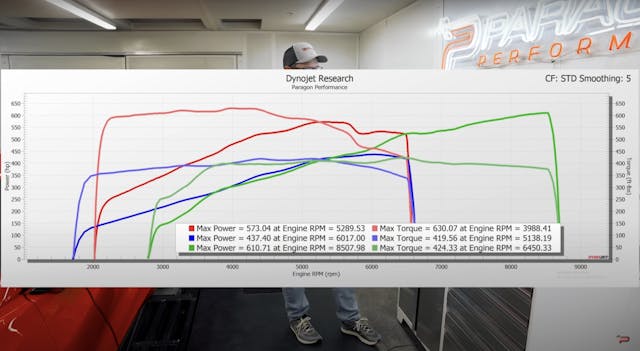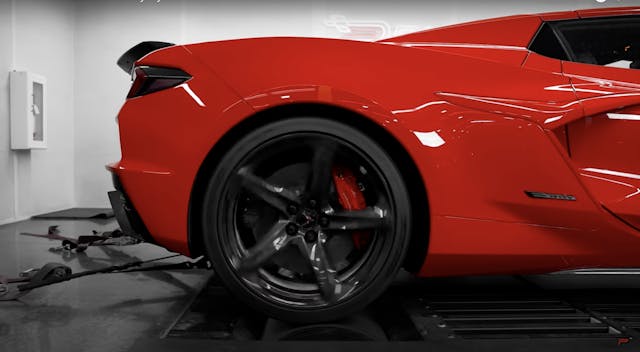Media | Articles
The Corvette E-Ray Makes Even More Torque Than You Think
If you were skeptical that the Corvette got soft when it went hybrid, the results of the first third-party dyno session with the E-Ray will convince you of the answer: Definitely not.
True, the driveline of the 2024 Corvette E-Ray pairs a familiar V-8 engine (the LT2) with an electric motor, and a 1.9-kWh lithium-ion battery is tucked under the center console. But the motor and battery are only good for four miles of driving range, and you can’t charge the battery with an external plug. The decision to add an electric motor, which powers the front axle, was a creative way to get more power output and greater traction, which together generate quicker acceleration. Fuel economy, if you’re wondering, doesn’t improve at all over the regular Stingray, which lacks the electric motor: Highway mileage is actually lower, by 1 mpg, according to the EPA estimate.
Those weren’t the numbers you really wanted to know, though.

Okay. Chevrolet advertises the total output of the engine plus motor at 655 hp (measured at the crank, as most manufacturers do) and 595 lb-ft of torque. Of course, we all wanted to verify those for ourselves, and we finally can, thanks to one E-Ray owner named Steve (thanks, Steve!) who sent his Torch Red E-Ray to the GM performance specialists at Paragon Performance in Waukee, Iowa, for a dyno sesh. Being a conscientious owner, he had them drive the car from Kansas City to Waukee so that the engine got its mandatory 500-mile break-in period before running at full throttle on Paragon’s dyno.
Paragon was particular about setting up its dyno: The technicians linked the front roller to the back one with a giant belt to replicate real-world conditions, to which the electric motor and the engine would both contribute maximum power.
Marketplace
Buy and sell classics with confidence
The results? 573 wheel horsepower—less than the factory number, as you’d expect, due to driveline losses—but 630 lb-ft of torque: 35 more than stock, even with those same losses.
We see you, Chevy …
Paragon didn’t stop there, of course. Graham, the host of the recorded session, walks us through the graphs, comparing the power curves of the E-Ray (in red) to those of the base car, the Stingray (blue), and to those of the track-focused Z06, which uses a different V-8 (the flat-plane-crank LT6) and no electric motor. The Stingray and the E-Ray are more comparable in mission and focus than the E-Ray and the Z06, so Graham starts there:

You might expect the electric motor to present as a more marked spike, but even as the motor reaches its maximum rpm, and as the heat generated by that motion begins to sap its power, the E-Ray makes more power than the base car through the entire rev range, including at redline, where it makes 100 more horses (at the wheels). From 2000 through about 4200 rpm, the hybrid Vette makes 200 more lb-ft than the base car, thanks to that electric motor. And Chevrolet only quoted the E-Ray’s electric motor at 160 hp and 125 lb-ft, measured at the crank!
Unsurprisingly, the Z06 (green) upstages both its siblings: After 6500 rpm, the horsepower curve generated by the flat-plane-crank model just keeps going, up to its redline of 8500 rpm.

It’s safe to say that the Corvette became a hybrid in the name of performance and power. Chevrolet’s reasoning will be further proven by the upcoming Zora, which is expected to combine the flat-plane-crank LT6 from the Z06 with two turbochargers (the combo that will distinguish the ZR-1) and an electric motor for the front axle. Steve, the owner of the E-Ray you see here, is putting his own spin on the formula: From Paragon Performance, this E-Ray will go to Wixom, Michigan, home of Corvette tuning shop Lingenfelter Performance, to receive its Magnuson supercharger kit. Thus blessed, the E-Ray will return to Paragon for another dyno sesh.
We like how you roll, Steve.
***
Check out the Hagerty Media homepage so you don’t miss a single story, or better yet, bookmark it. To get our best stories delivered right to your inbox, subscribe to our newsletters.















Not surprising, but this would bode well for most drivers, even those visiting the track for the occasional track experience. Most driver’s drive “torque” anyway, as that is a very usable rpm range for most skill levels and day to day applications. It takes quite a skilled driver to drive a high rpm or horsepower range consistently on the track. Most drivers are not that good.
Funny how the people most against EVs could get in an E-Ray and won’t hear the V8 over the electric motor.
Me? Someone, somewhere is working on a sound system and a seat option to simulate the rumble & shaking of any car you choose to pretend be that day…
“Hmmm, what shall it be today? A Pontiac GTO or a Ferrari GTO?”